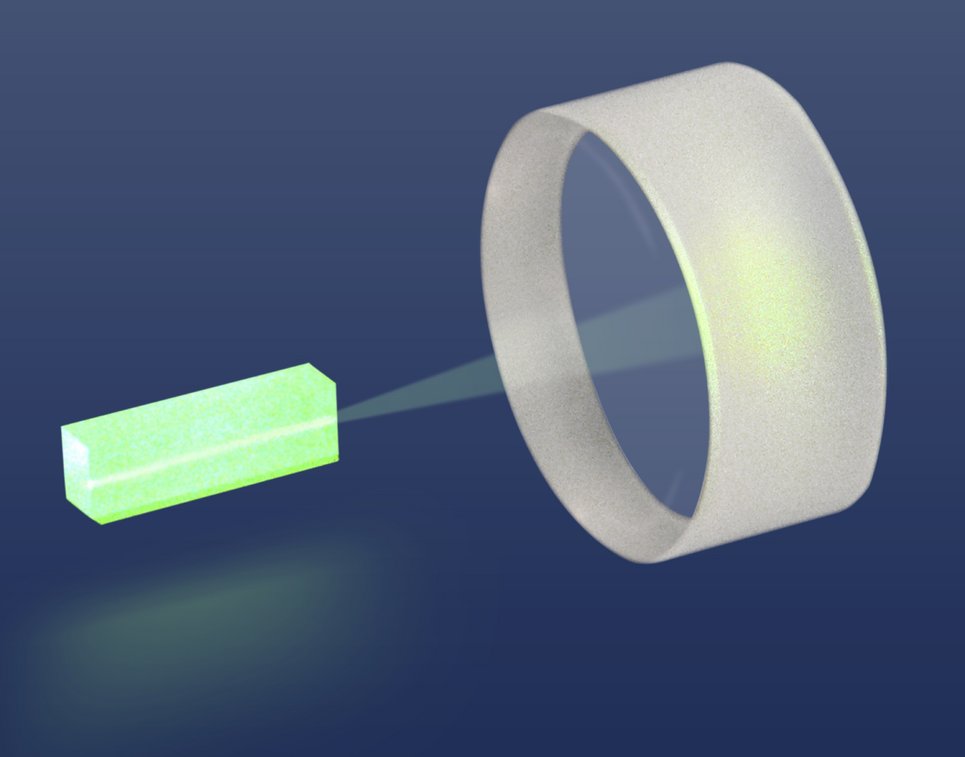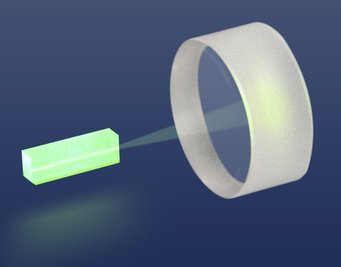The laser with the lowest noise level in the world
Researchers from Hanover outsmart quantum physics and arrange light particles of a laser beam in an evenly distributed manner
Researchers from the Max Planck Institute for Gravitational Physics and the Leibniz Universität Hannover have produced a laser beam of especial quality. The physicists have thereby set a world record in the control of photons or light particles. They were successful in precisely rearranging light particles in a laser beam. They thereby reduced the tiny quantum mechanical intensity fluctuations of the light that physicists call photon noise by a record value of 90 percent. Through laser light with such an extremely low noise level, the sensitivity of gravitational wave detectors can be enormously increased. However, squeezed light could also be used in quantum cryptography - for the tamper-proof encryption of messages. (Physical Review Letters, January 25, 2008)
Not all light is the same. There is the ordinary light of a light bulb, there is laser light and there is squeezed light, which is of an especially high quality. In a beam of squeezed light, physicists keep the intensity, i.e. the number of light quanta or photons, almost constant over a certain period of time. In a normal light beam, and even in a conventional laser beam, these quanta are randomly distributed. This is generally called for by the randomness principle of quantum physics. Sometimes many quanta come as a group, sometimes they come in isolation. It is like a rain shower in which sometimes more and sometimes less drops fall upon the earth. This variation of intensity, which is referred to as called photon noise, interferes with particularly sensitive measurements.

Physicists of the Max Planck Institute for Gravitational Physics (Albert Einstein Institute) and the Leibniz Universität Hannover have now reduced the photon noise to one tenth or, as one says in the jargon of physicists, they have “squeezed it.” This constitutes a world record. A few months earlier they had already set another world record: they moved light particles by up to half a second, longer than ever before, to arrange them evenly. “The randomness principle of quantum physics is not thereby violated," says Roman Schnabel, Junior Professor at the Leibniz Universität Hannover and at the Max Planck Institute for Gravitational Physics. “Just as before, the appearance of photons is still unpredictable. But we can link them together in such a way that they accept regular distances." This effect is what physicists call entanglement.
More sensitive gravitational wave detectors
“Thanks to our technology, we will now be able to significantly increase the sensitivity of the gravitational wave detector GEO600,” says Schnabel. The technology is even being incorporated into the much larger U.S. LIGO detectors. With such detectors scientists can more easily seek to detect gravitational waves, which they have to measure with the utmost precision. Another application potential for squeezed light is optical data transmission. It allows data to be securely encrypted, because an interception thereof would destroy the regular arrangement of the light particles and therefore would be easy to detect. “However, we are still in the infancy of applied quantum cryptography,” says Schnabel.
Usually, the intensity fluctuations in a light beam do not stand out, because each light particle carries only a small amount of energy. Physicists must look very carefully to detect such variations. This is precisely what is being done at the Albert Einstein Institute. In their gravitational wave detector GEO600 near Hannover, they use laser beams to measure tiny distance changes. They are thereby seeking to detect gravitational waves from the cosmos. These measurements are so sensitive that the photon noise of the laser light is clearly noticeable.
Crystals used for the storage of light
All current gravitational wave detectors use infrared laser light. The extremely uniform laser beams that Roman Schnabel and his colleagues can now generate will allow these detectors to be enormously improved. “This process involves the sorting of the light quanta of laser beams and arranging them in a more regular fashion,” explains Roman Schnabel. This is achieved by means of double-breaking, non-linear crystals. They are illuminated with a green laser beam that is exactly half the wavelength of infrared beams. “This laser prepares the crystal so that it squeezes the infrared light,” says Schnabel. The green laser beam polarizes the crystal, thus oscillating the electron shells of the crystal atoms – at precisely the frequency of the green laser itself. In this state, the crystal can store photons of an infrared laser beam. This is precisely what happens when the light particles of the infrared laser hit the crystal. If the stream of infrared photons once again becomes thinner, then it is filled up with the light stored in the crystal. Thus, the photons are more evenly arranged.
“With the squeezed laser light that we can produce, it is possible to more than triple the range of gravitational wave detectors,” says Roman Schnabel. This would thereby even enable one to observe the merging of light black holes at the edge of the universe. This is not possible with other current measurement methods. A gravitational wave detector, such as GEO600 near Hannover, consists of two right-angled tunnels, in which laser beams travel between mirrors. At one point the tunnels meet. There the rays superimpose and create a light pattern - a so-called interference pattern.
If a gravitational wave from the cosmos hits the detector, then it either slightly pulls or compresses the tunnel. As a result, the distance travelled by the laser beam changes, so that another interference pattern is produced at short notice. Sensitive measuring instruments record this and allow researchers to recognize gravitational waves that are passing through - at least in theory.
A ruler for a fraction of an atomic radius
In reality it has not yet been possible to directly measure gravitational waves. The problem is that the changes to be measured are too miniscule. When a gravitational wave hits the GEO600 detector, it changes the length of its tunnel by a mere ten trillionth of a millimetre, which is a billion times smaller than the diameter of an atom. In order to measure such minute distances, the laser beams which generate the interference pattern must have the most consistent level of intensity possible. This is because every variation in brightness changes the pattern of superimposition of the rays, thereby merely simulating the presence of a gravitational wave that is passing through.
Therein lays the advantage of squeezed laser beams: because they have an extremely consistent level of intensity, they produce a very stable interference pattern. The detector thereby becomes more sensitive, can detect weaker waves and listen deeper into the universe. Gravitational waves are created when large masses change their motion - when, for example, black holes whirl around each other or neutron stars vibrate. If it were possible to measure gravitational waves, astrophysicists could observe black holes, look into the interior of neutron stars and learn more about the mystery of dark matter. With normal telescopes such dark objects are not visible.
